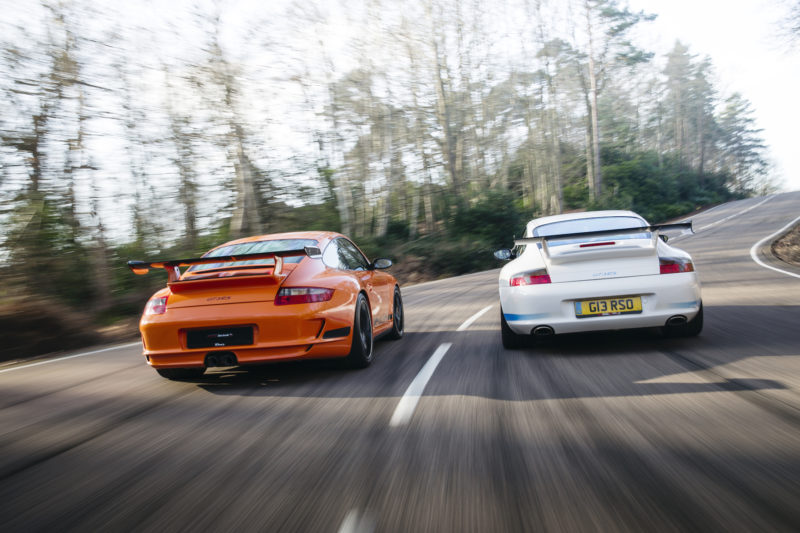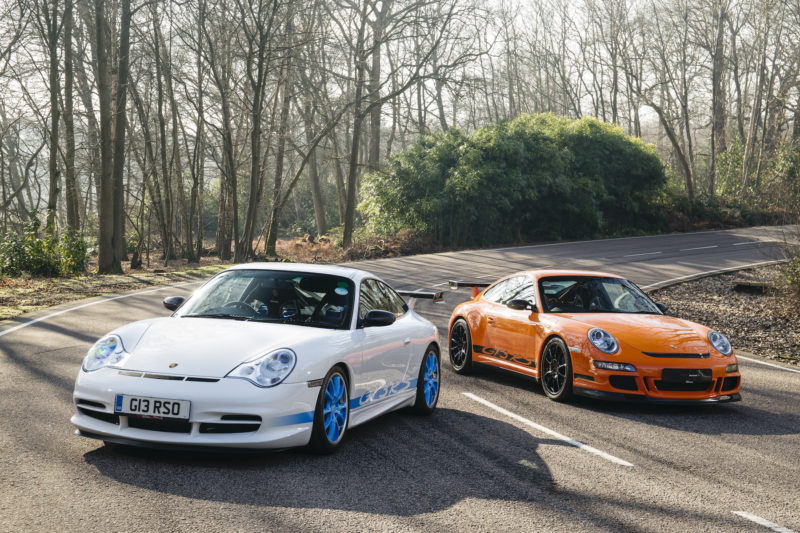Battle of the early modern Rennsports: 996 v 997.1 GT3 RS
“We built it without management knowing,” admits GT product line director, Andreas Preuninger. He took a standard GT3 and, taking inspiration from the blue-on-white Carrera 2.7 Carrera RS picture he loved as a kid, created the 996 GT3 RS. The management said yes, hoodwinked slightly as to the changes the engineer had made to the GT3 to create the new Rennsport.
The engines were a bit more special than anyone would admit openly at the time, the quoted output the same 381hp of the regular GT3 because of the cost and hassle of homologating the revised engine. In reality though the 3.6-litre boxers in the RS were a little bit more special, with reshaped intake and exhaust ports among some other detailed changes. Preuninger has also previously admitted to us that none left the GT department with less than 400hp too, by the way.
Visually the 996 GT3 RS’s inspiration unashamedly nods to that 2.7 RS, it only being offered in white, with either contrasting red or blue wheels and GT3 RS decals along its lower flanks. Its 18-inch wheels were part painted, part polished, evoking the 2.7 RS’s Fuchs.

Compared to the standard GT3, the 996 RS looked more overtly race car, helped no end by its standard white paintwork, the three outlets fore of the bonnet to vent radiator air, the lightweight composite bonnet above topped by a sticker not a badge. And not forgetting the rear wing – how could we – which looked so preposterous when new, but now looks relatively restrained.
Under it is a scoop intake on the plastic engine cover, which thanks to ram air effect at speed, means even more power when you need it. Carbon composite rear wings and door mirrors were added to remove mass, as was an acrylic rear window, while the loss of a good deal of sound deadening meant the GT3 RS delivered a kerbweight of 1,360kg, some 20kg less than the GT3.
Homologation obviously played its part in the chassis’ specification, too. The wheel carriers are strengthened to improve camber control, Porsche describing them simply as ‘special wheel carriers from racing’, while the top mounts are strengthened and can be moved. Likewise, the control arms are adjustable front and rear.

Revised springs and damper settings feature, too, with the springs being progressive rather than linear and the dampers tuned to suit them. It sits 3mm lower on its suspension than its Gen2 GT3 relation, those wheels filling the arches on the standard narrow bodywork.
It looked overt, pugnacious even, when it was new back in 2004, though today it looks neat and delicate, not just with the passage of time, but alongside its 997.1 GT3 RS replacement. The slim-hipped simplicity of the 996 GT3 RS is obvious in comparison to the orange 997.1 GT3 RS, the differences so marked it’s almost inconceivable that they’re only separated by a couple of years.
Unveiled at the 2006 Paris Motor Show, ‘Mondial de l’Automobile’, the 997 is a riotous mix of aerodynamic aids, intakes, vents and greater width. It gained the wider bodywork of the Carrera 4, for a 44mm wider rear over its regular GT3 relation. That increase was implemented to cover the wider rear track, it specified to improve the roll stiffness and, as Porsche so Germanically described it, ‘transverse acceleration potential’, for which you can read ‘cornering speed’.
Get our full head to head comparison of the 996 v 997 GT3 RS delivered to your door as part of our lavish magazine dedicated only to the Porsche 911! You can also download a digital copy with high definition bonus galleries to any Apple or Android device.

Comments (0)